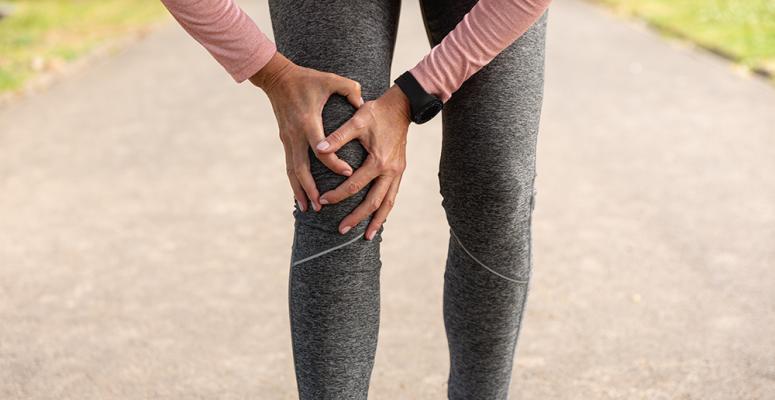
If you’re experiencing knee pain and foot or ankle pain in the same leg, it can be hard to tell if you’ve got one injury or two different ones. The good news is that knee pain and ankle pain in the same leg can often be traced back to the one single cause. Because these joints are stacked on top of each other and often move in tandem, the inflammation and injuries of one may have significant effects on the other.
With that said, if you’ve got intense or ongoing pain in both your knee and ankle joints in the same leg, it’s time to consider seeing a health care provider. There are at least eight different possible causes for pain in the right or left knee and ankle. After an assessment, a physical therapist should be able to narrow down what’s potentially causing your pain and create a personalized treatment plan.
This article will outline eight of the most common causes for knee and ankle pain in the same leg.
8 common causes of knee and ankle pain in the same leg
Your age, your lifestyle and your hobbies are all factors that may contain clues about your pain. However, you don’t have to move around a lot to develop knee and ankle pain in the same leg. Symptoms like this can show up from standing for long periods of time or even stem from your sleeping position.
- Sprain or strain — Both traumatic injuries and frequent overuse can cause sprains and strains that affect multiple locations on the same side of the body. You may find that you’re compensating for the pain in one joint by adjusting the way you walk. Over time, this can lead to more muscle strain, ligament tears or inflammation in adjacent joints.
- Sleeping position — Sleeping on your back or your side can put pressure on your knee joints. To improve circulation and reduce pain and stiffness, try using a pillow. Place it between your knees if you’re a side sleeper or underneath them if you’re a back sleeper.
- Tendinitis — The peroneal tendons run from the upper leg through the knee, ankle and foot. When these get inflamed, people often feel pain down the length of the leg or in the knee, ankle and foot joints.
- Joint damage — It is possible to have joint damage in both the ankles and the knees simultaneously. When the pain and inflammation flare up simultaneously, it can feel like they share a common cause.
- Plantar fasciitis — Plantar fasciitis is a common cause of pain in the bottom of your heel, and it can also radiate up to your knee. Runners, people who are overweight, and people with flat feet or high arches may be prone to plantar fasciitis.
- Osteoarthritis — Osteoarthritis is a condition that causes the joints and bones in the body to deteriorate over time. A person with osteoarthritis may develop pain in an affected leg around the hip, knee and ankle joints.
- Sciatica — Pressure on your sciatic nerve is known as sciatica. This nerve starts at the base of your spine and splits through the length of each leg. This condition involves chronic nerve pain in the lower half of the body, which can feel like weakness or loss of feeling in the legs or feet.
- Bursitis — Bursae are fluid-filled sacs that cushion the joints; they can become inflamed from repetitive overuse and traumatic injury. Bursitis typically causes pain at the hip or the knee, but again, compensating for pain in one joint can cause pain in other areas.
Physical therapy techniques for knee and ankle pain
There are several physical therapy treatments that can relieve knee and ankle pain in the same leg. Manual therapy is one of the most common methods, in which the therapist uses their hands to manipulate or apply pressure to different parts of the body. Joint mobilization and strain-counterstrain therapy are both manual therapy techniques that can improve mobility and range of motion in the joints.
Dry needling and kinesiology taping are two techniques that require some equipment. In dry needling, the therapist inserts thin needles into the skin to relieve muscle tension, decrease pain, increase blood flow and restore mobility. Your therapist might recommend dry needling if scar tissue or muscle tightness is causing your knee and ankle pain. In certain cases, they might recommend kinesiology taping. Kinesiology tape is heat-resistant, durable elastic tape that your therapist will place in strategic positions to pull targeted areas away from one another, reducing friction and allowing for free range of motion.
Finally, strength restoration exercises and guided stretching are things your therapist can show you during your appointment. They may also ask you to do some of these exercises at home between appointments. Check out some of our favorite exercises and stretches for an injured ankle or the ACL and MCL ligaments in your knees.
Alliance PTP can help find expert physical therapists near you to address knee and ankle pain in the same leg
You probably don’t have to go as far as you think to get help with knee and ankle pain in the same leg. After all, Alliance Physical Therapy Partners has practices across the country where you can find the physical therapy you need.
So, don’t keep letting your symptoms affect your day-to-day life. Get in touch with our team today so we can help you find the physical therapy that’s right for you.
Get Help at a Location Near You
